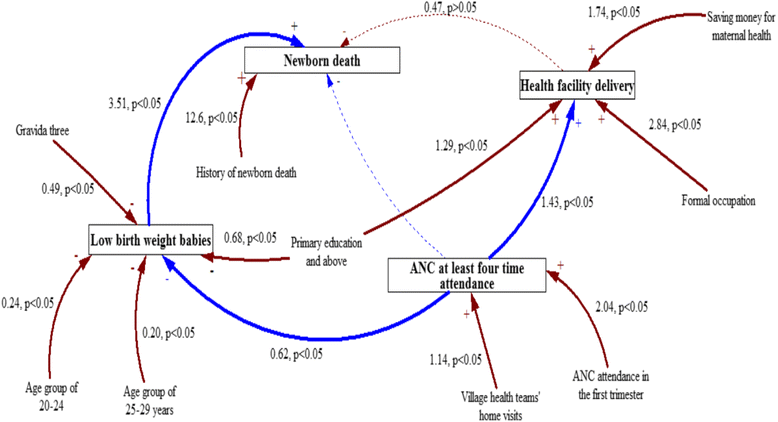A structural equation analysis on the relationship between maternal health services utilization and newborn health outcomes: a cross-sectional study in Eastern Uganda
- PMID: 28347281
- PMCID: PMC5369185
- DOI: 10.1186/s12884-017-1289-5
A structural equation analysis on the relationship between maternal health services utilization and newborn health outcomes: a cross-sectional study in Eastern Uganda
Abstract
Background: Neonatal and maternal health services have a bearing on neonatal mortality. Direct and indirect factors affecting neonatal health outcomes therefore require understanding to enable well-targeted interventions. This study, therefore, assessed the interrelationship between newborn health outcomes and maternal service utilization factors.
Methods: We investigated maternal health utilization factors using health facility delivery and at least four Antenatal Care (ANC) visits; and newborn health outcomes using newborn death and low birth weight (LBW). We used data from a household cross-sectional survey that was conducted in 2015 in Kamuli, Pallisa and Kibuku districts. We interviewed 1946 women who had delivered in the last 12 months. The four interrelated (Endogenous) outcomes were ANC attendance, health facility delivery, newborn death, and LBW. We performed analysis using a structural equation modeling technique.
Results: A history of newborn death (aOR = 12.64, 95% CI 5.31-30.10) and birth of a LBW baby (aOR = 3.51, 95% CI 1.48-8.37) were directly related to increased odds of newborn death. Factors that reduced the odds of LBW as a mediating factor for newborn death were ANC fourth time attendance (aOR = 0.62, 95% CI 0.45-0.85), having post-primary level education (aOR = 0.68, 95% CI 0.46-0.98) compared to none and being gravida three (aOR = 0.49, 95% CI 0.26-0.94) compared to being gravida one. Mother's age group, 20-24 (aOR = 0.24, 95% CI 0.08-0.75) and 25-29 years (aOR = 0.20, 95% CI 0.05-0.86) compared to 15-19 years was also associated with reduced odds of LBW. Additionally, ANC visits during the first trimester (aOR = 2.04, 95% CI 1.79-2.34), and village health teams (VHTs) visits while pregnant (aOR = 1.14, 95% CI 1.01-1.30) were associated with increased odds of at least four ANC visits, which is a mediating factor for health facility delivery, LBW and newborn death. Surprisingly, newborn death was not significantly different between health facility and community deliveries.
Conclusions: Attending ANC at least four times was a mediating factor for reduced newborn death and low birth weight. Interventions in maternal health and newborn health should focus on factors that increase ANC fourth time attendance and those that reduce LBW especially in resource-limited settings. Targeting women with high-risk pregnancies is also crucial for reducing newborn deaths.
Keywords: Interrelationship; Maternal health utilization; Newborn outcomes; Structural equation modeling.
Figures
Similar articles
-
Association between adequacy of antenatal care and neonatal outcomes in Rwanda: a cross-sectional study design using the Rwanda demographic and health surveys.BMC Health Serv Res. 2023 Dec 8;23(1):1379. doi: 10.1186/s12913-023-10345-6. BMC Health Serv Res. 2023. PMID: 38066497 Free PMC article.
-
Effect of a participatory multisectoral maternal and newborn intervention on maternal health service utilization and newborn care practices: a quasi-experimental study in three rural Ugandan districts.Glob Health Action. 2017 Aug;10(sup4):1363506. doi: 10.1080/16549716.2017.1363506. Glob Health Action. 2017. PMID: 28871853 Free PMC article.
-
Determinants of late antenatal care attendance among high parity women in Uganda: analysis of the 2016 Uganda demographic and health survey.BMC Pregnancy Childbirth. 2024 Jan 5;24(1):32. doi: 10.1186/s12884-023-06214-z. BMC Pregnancy Childbirth. 2024. PMID: 38183021 Free PMC article.
-
Place of delivery and perinatal mortality in Kenya.Semin Perinatol. 2019 Aug;43(5):252-259. doi: 10.1053/j.semperi.2019.03.014. Epub 2019 Mar 16. Semin Perinatol. 2019. PMID: 31104765 Review.
-
Predictors of Poor Neonatal Outcomes among Pregnant Women in Indonesia: A Systematic Review and Meta-Analysis.Nutrients. 2022 Sep 10;14(18):3740. doi: 10.3390/nu14183740. Nutrients. 2022. PMID: 36145116 Free PMC article.
Cited by
-
The effects of completion of continuum of care in maternal health services on adverse birth outcomes in Northwestern Ethiopia: a prospective follow-up study.Reprod Health. 2022 Oct 8;19(1):200. doi: 10.1186/s12978-022-01508-5. Reprod Health. 2022. PMID: 36209163 Free PMC article.
-
Association between quality antenatal care and low birth weight in Rwanda: a cross-sectional study design using the Rwanda demographic and health surveys data.BMC Health Serv Res. 2023 May 30;23(1):558. doi: 10.1186/s12913-023-09482-9. BMC Health Serv Res. 2023. PMID: 37254102 Free PMC article.
-
The effects of adherence to recommended antenatal services on adverse pregnancy outcomes in Northwest Ethiopia: multilevel and propensity score matching (PSM) modeling.Front Glob Womens Health. 2023 Jun 26;4:1082405. doi: 10.3389/fgwh.2023.1082405. eCollection 2023. Front Glob Womens Health. 2023. PMID: 37434914 Free PMC article.
-
The Use of Facilities for Labor and Delivery: The Views of Women in Rural Uganda.J Public Health Afr. 2017 Sep 4;8(1):592. doi: 10.4081/jphia.2017.592. eCollection 2017 Jun 23. J Public Health Afr. 2017. PMID: 28890773 Free PMC article.
-
Assessing the application of adapted theory of planned behaviour in predicting postpartum family planning intentions in a pragmatic randomized control trial in Western Kenya.PLoS One. 2025 Feb 5;20(2):e0315029. doi: 10.1371/journal.pone.0315029. eCollection 2025. PLoS One. 2025. PMID: 39908241 Free PMC article. Clinical Trial.
References
-
- UNICEF. The State of the World’s Children 2014 -Every Child Counts. New York; 2014. http://www.unicef.org/sowc2014/numbers/documents/english/SOWC2014_In Numbers_28 Jan.pdf.
MeSH terms
LinkOut - more resources
Full Text Sources
Other Literature Sources
Medical


